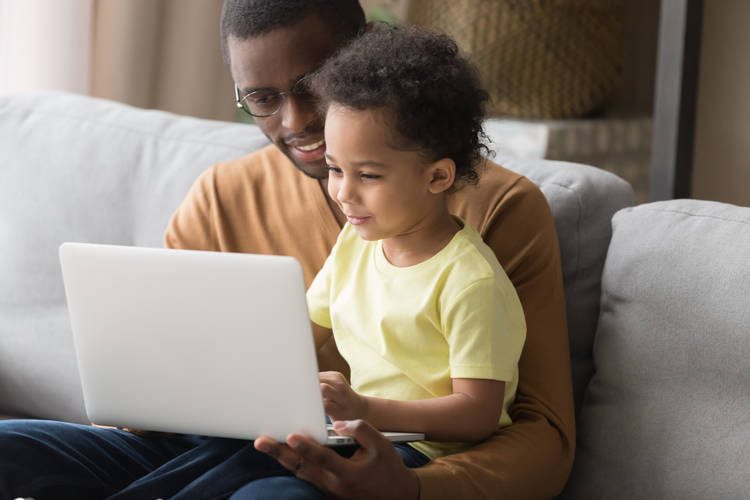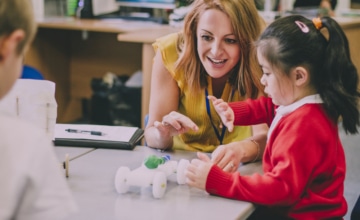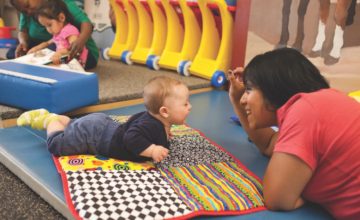Lisa Guernsey, New America, Washington, DC

Abstract
Media literacy experts have been teaming up with early childhood practitioners to develop a framework for a new way of thinking about raising kids in a digital and media-centric world. Their ideas are encapsulated in the Media Literacy in Early Childhood Report (Herdzina & Lauricella, 2020) that explores how to help young children learn how to understand media content arriving through all sorts of tools and within many different forms—from the pages within books to images on a screen. This article gives background on the origins of early media literacy education and describes multiple examples from personal interviews and activities included in the report.
The summer of 2020 was a tumultuous, emotionally charged time for Americans everywhere—and it was especially difficult for parents and caregivers raising young kids. With COVID-19 forcing the closure of child care centers, schools, museums, and libraries, caregivers had to figure out how to keep their kids learning and occupied while also coping with the anxiety and outrage triggered by racial injustices and protests. TV news, apps and games on smartphones, and social media networks became the conduit for disturbing news, needed distractions, and human connection, all at the same time.
Amid this avalanche of calamity, the Erikson Institute published a new resource, the Media Literacy in Early Childhood Report (Herdzina & Lauricella, 2020). Buried under the news last summer, it should be excavated for a longer look. It provides a framework for a new way of thinking about raising kids today. The report takes an approach that doesn’t fixate on new technology and screens but instead turns one’s attention to media content arriving through all sorts of tools and within many different forms—from the pages within books, to billboards on the road, to graphics on cereal boxes, and, yes, to images on a screen.
“We need to start talking about this at the early ages,” says Alexis R. Lauricella, co-author of the report (with Jenna Herdzina) and executive director of the Technology in Early Childhood (TEC) Center at Erikson Institute. Pandemic-induced virtual learning scenarios have added momentum to the effort. “Now with younger and younger children using digital devices to connect,” Lauricella says, “a lot more people are coming to the understanding that ‘Oh wow, we should be talking about this’” (A. Lauricella, personal communication, September 11, 2020).
The report is a hallmark of a new theory emerging in early childhood circles—that just as children benefit from experiences with books and speech at an early age, they also can benefit from chances to learn about the plethora of tools and strategies people use to communicate and distribute messages to each other. The approach takes cues from the abundance of scientific studies on the importance of adult–child interactions, recognizing that children will likely learn best when they are with caregivers, parents, and educators who engage them in conversation about what they are seeing, viewing, and playing with. These adults will be the key to helping children build skills for sharp thinking about the media when they get older.
But how young to start? It may be easy to visualize an elementary school student learning media literacy by, say, creating an electronic story book or having a class discussion on the meaning of a school’s logo. It is more of a stretch to imagine what this looks like with children who are just learning to talk. The Erikson report does not shy from these questions; it really does mean early childhood. Concepts related to media literacy skill-building start at the very beginning of children’s lives. The report gives pages of specific examples for engaging children as they grow each year, from birth through 8 years old.
What becomes clear is that the appropriateness of the activity depends very much on the age and stage of a child’s development. It would not be appropriate to expect a 12-month-old baby to identify the intent of an advertisement, let alone have a clue about what the word “advertisement” means. But at 12 months, babies have begun to learn that communication is a two-way street, and that their actions—their smiles, their cries—elicit a response in others.
And while children at this age may not be using digital devices, these devices are in their line of sight and in their parents’ hands all the time.
“Caregivers are regularly using cameras, mobile phones, and tablets to capture images and videos of their children and often show the child the resulting image on their digital device,” the report points out. “Adults are regularly using media themselves, thereby modeling the use of these tools for children starting at birth” (Herdzina & Lauricella 2020, p. 10). In short, the seeds for learning about and understanding media and communication are planted when children are young enough to be looking at, exploring, listening to, and observing the world around them.
Finding the Right Words
Building a case for taking a new approach to teaching children does not happen overnight. Some of the groundwork for bringing media literacy into early childhood classrooms was laid more than 20 years ago when Cyndy Scheibe of Ithaca College developed Project Look Sharp, which provides curricular materials for teaching media literacy, including activities for kindergarten and first grade. Faith Rogow, now CEO of Insighters Educational Consulting, was a key advisor on the project and the two of them were in the founding group of what became known as the National Association for Media Literacy Education.
Another pioneer in the space is Vivian Vasquez, an American University education professor who has written several books and chapters about how to help young children build skills of inquiry and observation while using media of all kinds. Her first book, Negotiating Critical Literacies With Young Children, arrived in 2004, prompting new discussion of how to support children as they observe and inquire. Not too long after, Scheibe and Rogow published The Teacher’s Guide to Media Literacy: Critical Thinking in a Multimedia World (2011), providing in-classroom examples and persuasive arguments about how media literacy extends children’s thinking.

Children will likely learn best when they are with caregivers, parents, and educators who engage them in conversation about what they are seeing, viewing, and playing with. Photo: shutterstock/aslysun
Meanwhile, in the realm of children’s media developed for the screen, the Joan Ganz Cooney Center at Sesame Workshop published The New Coviewing (Takeuchi & Stevens, 2011), a look at research on how adults and children jointly attend to and learn from screen media, and my book written for parents, exploring the science of how children learn from video and interactive media, was published in a second edition as Screen Time: How Electronic Media—From Baby Videos to Electronic Software—Affects Your Young Child (2012). That same year, the National Association for the Education of Young Children paired up with the Fred Rogers Center for Early Learning & Children’s Media at Saint Vincent College to publish a position statement on children and interactive technology, which provided guidance on using screen media and other digital tools with young children.
By then touchscreens and smartphone apps had opened fresh controversies on how, if, and why to engage young children with technology. Often the debates focused on the amount of time spent with a particular tool instead of the content and messages of the media children and families were consuming or the context in which they were using it. But many educators continued to move toward some of the media literacy strategies that considered the broader universe of media that children are using, whether in the pages of a book or on a screen. In 2017, the TEC Center at Erikson Institute co-hosted a preconference workshop with the National Association for Media Literacy Education, which provided a crucial opportunity for early childhood educators to learn together with media literacy educators.
A next big step came when the Institute for Museum and Library Services, which had become increasingly interested in how to support the field of early childhood and families with young children, decided in 2018 to fund the multiyear project that led to the Herdzina and Lauricella (2020) report. The project was led by the TEC Center conducted in partnership with the National Association for Media Literacy Education (NAMLE), the Association for Library Service to Children, and the Association of Children’s Museums. The project brought teachers, librarians, leaders in children’s museums, researchers, and early education experts from across the United States to two day-long forums in Chicago in 2019 and culminated in the Media Literacy in Early Childhood Report.
Full disclosure: I participated in these forums, and the work was fascinating—and difficult. The other attendees and I faced two assignments: arrive at a consensus on how to define media literacy for young children, and get practical so we could provide specific examples of activities and moments of interaction that could advance a child’s understanding of media and help develop emergent media literacy skills.
Fortunately, for our first assignment, we did not have to start from scratch. NAMLE, which is comprised of educators and faculty members who teach across the age spectrum up through college and adulthood, already has a definition (put forward in 2007) which provides a good foundation: “Media literacy is the ability to access, analyze, evaluate, create, and act using all forms of communication” (NAMLE, 2007).
Forum participants pondered how and whether NAMLE’s words would make sense from the perspective of early educators and parents who are working with very young children. The result was a tweaked version of the NAMLE definition to use with early childhood practitioners: “Media literacy in Early Childhood is the emerging ability to access, engage, explore, comprehend, critically inquire, evaluate, and create with developmentally appropriate media” (Herdzina & Lauricella, 2020, p. 7).
The words in bold are new words which formed the backbone for the rest of the report, providing action verbs for what young children could start to do, with adults’ support and scaffolding, to develop media literacy skills (see Box 1).
Box 1. The Actions That Make up the Framework
of the Media Literacy in Early Childhood Report
can be supported by adults, to help them gain media literacy skills.
As the report put it: Young children need to be given support to do
the following:
1. Access: to effectively locate, use, and select media
2. Engage and Explore: to intentionally use media for purpose
and enjoyment
3. Comprehend: to understand media messages and practices and
transfer that knowledge appropriately
4. Critically Inquire: to question and analyze media messages
5. Evaluate: to ask “is this media right for me or my task?”
6. Create: to make media with intention
Source: Herdzina & Lauricella, 2020, p. 8.
The next task was to come up with a constellation of activities that could help parents and practitioners visualize what they could do with their children to foster these skills. And those activities had to be sorted and categorized so that teachers and parents could apply them to working with kids in any of four age groups—birth–2, 3–4, 5–6, and 7–8 years old—and understand the connections between media use and the stages of child development.
For example, as the report described, around 2 years old children are typically producing 50–200 words and starting to use word pairs to communicate. This is a critical time for adults to label and respond to children’s gestures about what they see around them. Around 4 years old, children “begin to understand that others can believe or know something contrary to what they know or understand” (Herdzina & Lauricella, p. 9)—a foundation for eventually learning that what they see on a page or on a screen was created by someone who is communicating a message from their particular point of view.
“This is the first effort I’ve seen that begins to look at what the developmental continuum could look like for the early years,” Rogow said. (F. Rogow, personal communication, August 5, 2020)
But the Erikson report does not assume that kids will learn skills by simply being exposed to media or technology. It puts the onus on caregivers, parents, and teachers to become more aware of how they (yes, the adults!) use media when they are with young children—and encourages adults to use those moments to give children some models for what it means to be media literate. Even the smallest of interactions can set conditions for children to develop healthy habits of mind, leading them to inquire about and learn how media is developed and why.
From Early Literacy to Early Media Literacy
Scheibe, the Ithaca College professor, has spent a good chunk of her life teaching educators how to bring those small interactions to life in early elementary classrooms. She and Rogow are strong proponents of the idea that media literacy is a critical form of literacy—of being a literate person in the world today—and that it starts by building on the same strategies associated with early and emergent literacy in children’s preschool, kindergarten, and first-grade years.
As Scheibe has pointed out, during storytimes and read-alouds, caregivers and teachers have already become accustomed to engaging in conversation with young kids. Sitting on the rug with a picture book, teachers often ask, “What do you think will happen next?” before turning the page. To help children learn habits of media literacy, these educators should respond to the kids’ feedback by asking one additional question: “What makes you think that?” In the ensuing dialogue, Scheibe explained, teachers can start “steering kids back to clues in the story or clues in the pictures” (C. Scheibe, personal communication, September 3, 2020). If a child predicts that Curious George is going to steal the man’s yellow hat, a teacher can ask what he saw on the previous page that made him think so—and then go back to that page to look again. These simple moments can help children to gain experience with some key actions associated with being media literate: critically inquiring and looking for evidence.
Part of modeling media literacy with young children starts with realizing that media is everywhere—not just on screens, but also on a box of diapers or in the images on board games young children play. Any time that an adult and child are jointly looking at, reading, or playing with a piece of media, that adult has the opportunity to inject some media literacy learning into the conversation. As public librarian Claudia Haines explained when describing the various activities outlined in the Erikson report, “These aren’t lesson plans. They’re moments” (Herdzina & Lauricella, p. 9).
Rogow, who is working on a new book for NAEYC titled Media Literacy for Young Children: Teaching Beyond the Screen Time Debate, agreed. This is “just changing up how we read aloud and ask questions about the text,” she said. Small changes in practice, she added, can have a big impact. And they can be embedded in conversations already taking place, “as simple as not answering your kid’s question with an answer but instead saying: How can we find out?” Scheibe, Rogow, and the report authors stressed that these activities do not have to feel burdensome. In another example, Rogow explained that a teacher can simply start by verbalizing her thought process, saying, “I think I’ll look at that site because….”
In short, the addition of a few simple sentences can help children see that they have choices of media (“I have two weather apps; let’s try this one.”) and that it can be valuable to evaluate and inquire (“This app says it will rain, but I don’t trust it because it has been wrong for weeks! I’m going to check the local newspaper today instead.”).
Media Making as a Literacy Skill
The previous examples include ways to engage young children in a number of the framework’s key six actions, whether it is to “engage and explore” or “evaluate.” The sixth action in the list—to “create”—may be the one that resonates the most with early childhood practitioners who stress the importance of hands-on activities, whether fingerpainting or filling out a classroom calendar with photos. And those practices could and should be imbued with many media literacy moments. But creating also includes writing code, programming robots, and filming and editing videos—options that are now increasingly accessible, with adults’ help, to kids as young as those in preschool and kindergarten.

The seeds for learning about and understanding media and communication are planted when children are young enough to be looking at, exploring, listening to, and observing the world around them. Photo: shutterstock/Prostock-studio
What might this creating look like? Pre-pandemic, libraries and museums offered nights for families with young children to come explore and use makerspaces, and schools and public media stations partnered with community centers to provide time and space for young kids and their parents to create and learn together. In the midst of the COVID-19 crisis, program leaders are trying to build versions of these creative moments through virtual meetings and by sending kits to families’ homes.
One example is Family Creative Learning (http://familycreativelearning.org), a program featuring five 2-hour sessions with parents and children working together after school to learn simple coding. The strategy, which emerged from research at the University of Colorado at Boulder and has been tested with parents and their children in several cities around the country, introduced families to ScratchJr, a programming language for early elementary-age children. Working together, parents and children create visual stories by dragging and dropping different sequences into a code that translates into a mini story appearing on the screen.
These family nights inspired a similar program, Family and Community Collaborative Workshops, now embedded in the Ready to Learn program run by the Corporation for Public Broadcasting and PBS and piloted with 30 public television stations around the country. Families are invited to come for a meal, are given time to talk together, view various media clips from PBS shows, and rotate through various tables with craft materials for building together. In workshops centered on the PBS show Molly of Denali, a show designed to support learning about informational texts, families learn about stories told from the perspective of an Alaskan Native girl and her family. After an introduction to the show, says Lavanya Mohan, PBS’s director of family and community learning, children and parents created and chose materials from their day-to-day lives to include in a museum exhibit about who they are and where they come from (L. Mohan, personal communication, September 28, 2020).

Any time that an adult and child are jointly looking at, reading, or playing with a piece of media, that adult has the opportunity to inject some media literacy learning into the conversation. Photo: shutterstock/fizkes
The aim of these collaborative workshops is that as young children get opportunities to explore and learn how texts, games, or even museum exhibits are made, they gain a deeper understanding of who and what is behind the messages they see and how to talk with parents and siblings about them. Research from Junnan Yu and colleagues at the University of Colorado at Boulder provides some evidence that these efforts make a positive difference. They conducted multiple observations of and in-depth interviews with 18 parents who received coding kits to use with their children. They reported, “For six parents, playing with coding kits helped demystify technology for their children and encourage the children to think about the mechanisms behind computers and technologies.” One parent, for example, reported that learning to code has given her child “more appreciation for how much [work] and the hidden things of so many programs and apps” (Yu, Bai, & Roque, 2020).
In this way, teaching media literacy skills is akin to building “computational thinking” skills, another approach to teaching that is gaining currency among education leaders (Campana et al., 2020). Both skills and habits of mind can be introduced to young children in developmentally appropriate ways, including through play and in joint engagement with their siblings and parents.
When They Grow Up
In the future, today’s infants and toddlers will be navigating even more media messages on even more platforms than are being used today. In a dozen short years, they will be teenagers, learning from their peers through their smartphones or whatever device becomes the must-have of the future. And just a few years after that they will be adults, with adult decisions to make about voting, public health, how they communicate in their communities, and how they raise their own kids. They will need to know how to choose and use media for positive change and learning. They will need to be able to sort through what is of value, what is sheer satire, and what is propaganda.
This coming reality might lead one to think that parents and educators need to rush kids through media literacy training. But that is the opposite of the report’s message. Instead, the authors wrote, “Don’t expect children to be media experts or engage and explore with overt purpose right away. Slow down. Pause. Give children space” (Herdzina & Lauricella, p. 18). Teaching media literacy, the authors wrote, is not about pushing children to learn discrete skills in digital media and technology use. It cannot happen in an accelerated time frame. Like reading, this literacy develops through practice and by fostering habits of mind rooted in inquiry. Rogow says these habits, such as asking “What makes us think that? How do we know? How might we find out?,” are learned over years of interacting with media of all kinds, and interacting with people, from a child’s earliest years, who can show them how to think critically about what they see and hear.
As Rogow said, “If we stop approaching media literacy as being about the technology and focus on it as being about literacy for the digital world, then it is not so strange to think about it for zero-to-3 year olds.”
Learn More
Association for Library Service to Children
www.ala.org/alsc
Association of Children’s Museums
www.childrensmuseums.org
National Association for Media Literacy Education
https://namle.net
Video from morning sessions of Media Literacy Starts Young: Strategies
for Media Mentorship in the Early Years and Early Grades (June 26, 2019), a pre-conference workshop hosted by New America for the National Association for Media Literacy Education’s 2019 biennial conference.
www.newamerica.org/education-policy/events/media-literacy-starts-young-strategies-media-mentorship-early-years-and-early-grades
Suggested Citation
Guernsey, L. (2020). Weaving media literacy into young children’s explorations on and off screens. ZERO TO THREE Journal, 41(2), 14–19.
Author Bio
Lisa Guernsey is director of the Teaching, Learning & Tech program and senior advisor to the Early & Elementary Education Policy program at New America. She also co-founded and leads the Learning Sciences Exchange fellowship program at New America. Guernsey focuses on new approaches to help students and families succeed in the Digital Age, and her work involves leading teams of analysts and writers to translate research, examine policies, and generate new ideas for developing high-quality learning opportunities for underserved and under-resourced populations. Prior to her work at New America, Guernsey was a staff writer at The New York Times and The Chronicle of Higher Education and has contributed to national publications including Scientific American, The Atlantic, The Washington Post, Newsweek, Time, Slate, and USA TODAY. She is co-author with Michael H. Levine of Tap, Click, Read: Growing Readers in a World of Screens (Jossey-Bass, 2015) and author of Screen Time: How Electronic Media—From Baby Videos to Educational Software—Affects Your Young Child (Basic Books, 2012). She has contributed to multiple books on technology and learning, including Technology and Digital Media in the Early Years (Routledge, 2014), Family Engagement in the Digital Age (Routledge, 2016), and Exploring Key Issues in Early Childhood and Technology (Routledge, 2019). Guernsey has served on several national advisory committees on early education, including the Institute of Medicine’s committee that led to the seminal 2015 report, Transforming the Workforce for Children Birth Through Age 8: A Unifying Foundation. She is currently on the LEGO FIRST Robotics Advisory Board.
References
Campana, K., Haines, C., Kociubuk, J., & Langsam, P. (2020). Making the connection: Computational thinking for young learners and their families. Public Libraries 59(4), 45–56. link
Guernsey, L. (2012). Screen time: How electronic media—from baby videos to educational software—affects your young child. Basic Books.
Herdzina, J., & Lauricella, A. R. (2020). Media literacy in early childhood report: Framework, child development guidelines, and tips for implementation. Erikson Institute: Technology in Early Childhood Center. ( http://teccenter.erikson.edu/publications/media-literacy-report)
National Association for the Education of Young Children & the Fred Rogers Center for Early Learning and Children’s Media at Saint Vincent College. (2012). Technology and interactive media as tools in early childhood programs serving children from birth through age 8. A joint position statement of the National Association for the Education of Young Children and the Fred Rogers Center for Early Learning and Children’s Media at Saint Vincent College. www.naeyc.org/content/technology-and-young-children
National Association for Media Literacy Education. (2007). Media literacy defined. https://namle.net/resources/media-literacy-defined
Scheibe, C., & Rogow, F. (2011). The teacher’s guide to media literacy: Critical thinking in a multimedia world. Corwin.
Takeuchi, L., & Stevens, R. (2011). The new coviewing: Designing for learning through joint media engagement. Joan Ganz Cooney Center at Sesame Workshop. link
Vasquez, V. M. (2004). Negotiating critical literacies with young children. Routledge.
Yu, J., Bai, C., & Roque, R. (2020, April). Considering parents in coding kit design: Understanding parents’ perspectives and roles. CHI ‘20: CHI Conference on Human Factors in Computing Systems. https://dl.acm.org/doi/10.1145/3313831.3376130




